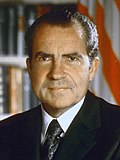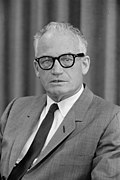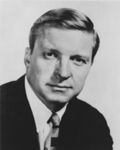Top Qs
Timeline
Chat
Perspective
1968 Republican Party presidential primaries
Selection of Republican US presidential candidate From Wikipedia, the free encyclopedia
Remove ads
From February 3 to July 13, 1968, voters of the Republican Party chose its nominee for president in the 1968 United States presidential election. Former vice president Richard Nixon was selected as the nominee through a series of primary elections and caucuses culminating in the 1968 Republican National Convention held from August 5 to August 8, 1968, in Miami Beach, Florida.[2]
Remove ads
Schedule and results
Summarize
Perspective
1968 Republican primaries and state conventions

Note:[c]
Remove ads
Candidates
Summarize
Perspective
The following political leaders were candidates for the 1968 Republican presidential nomination:
Nominee
Other major candidates
These candidates participated in multiple state primaries or were included in multiple major national polls.
Favorite sons
The following candidates ran only in their home state's primary, caucus, or convention. They ran for the purpose of controlling their state's respective delegate slate at the national convention and did not appear to be considered national candidates by the media. The media referred to them as "favorite son" candidates.
Declined to run
The following persons were listed in two or more major national polls or were the subject of media speculation surrounding their potential candidacy, but declined to actively seek the nomination.
- Senator Everett Dirksen of Illinois
- Senator Charles H. Percy of Illinois (endorsed Rockefeller)
- Senator Mark Hatfield of Oregon
- Senator Thruston Ballard Morton of Kentucky (endorsed Rockefeller)
- Representative Robert Taft Jr. of Ohio
- Governor Claude R. Kirk Jr. of Florida (endorsed Rockefeller)
- Former Governor John Davis Lodge of Connecticut (endorsed Nixon)
- Former Governor William Scranton of Pennsylvania
- Mayor of New York City John Lindsay (endorsed Rockefeller)
- Retired Lt. General James M. Gavin
Remove ads
Polling
Summarize
Perspective
National polling
See or edit source data.
Graph of opinion polls conducted
Before November 1966
- Nixon's official state of residence was New York because he moved there to practice law after his defeat in the 1962 California gubernatorial election. During his first term as president, Nixon re-established his residency in California. Consequently, most reliable reference books, including the January 6, 1969 edition of the Congressional Record, list his home state as New York.
- Favorite sons received the support of Alaska (Wally Hickel), Hawaii (Hiram Fong), New Jersey (Clifford Case), South Carolina (Strom Thurmond), Ohio (Jim Rhodes), Pennsylvania (Raymond Shafer), Maryland (Spiro Agnew), Texas (John Tower), Kansas (Frank Carlson), and Tennessee (Howard Baker).
- This should not be taken as a finalized list of results. While a significant amount of research was done, there were a number of Delegates who were not bound by the instruction, or "Pledged" to a candidate, though an attempt has been made to display their initial preferences. Some states also held primaries for the delegate positions, and these on occasion were where slates or candidates pledge to a certain candidate might be elected; however, as these elections allowed for a single person to vote for multiple candidates, as many as the number of positions being filled, it is difficult to determine how many people actually voted in these primaries. For this reason, while the results of some are in the table, they are not included in the popular vote summaries at the bottom of the table. Also information on Puerto Rico and the Virgin Islands, who elected five and three delegates respectively to the Republican Convention, was not found.
- The date is assumed; while scheduled for this date, it may have been interrupted by the Memphis Riots.
- Includes 18,800 Write-In votes (6.52%) for Eugene McCarthy, 13,290 Write-In votes (4.61%) for George Wallace, 10,431 Write-In votes (3.62%) for Robert Kennedy, 4,651 Write-In votes (1.61%) for Hubert Humphrey, 3,088 Write-In votes (1.07%) for Lyndon Johnson, and 1,271 Write-In votes (0.44%) for Raymond Shafer
- Includes 1,544 Write-In votes (0.77%) for Eugene McCarthy, 1,302 votes (0.65%) for Americus Liberator, 885 Write-In votes (0.44%) for Robert Kennedy, 533 Write-In votes (0.27%) for George Wallace, 219 Write-In votes (0.11%) for Hubert Humphrey, 32 Write-In votes (0.02%) for John Lindsay, and 19 Write-In votes (0.01%) for Lyndon Johnson.
After November 1966
Head-to-head polling
Nixon v. Romney
Statewide polling
New Hampshire
Remove ads
Primary race
Summarize
Perspective
Nixon was the front-runner for the Republican nomination and to a great extent the story of the Republican primary campaign and nomination is the story of one Nixon opponent after another entering the race and then dropping out.
Nixon's first challenger was Michigan Governor George W. Romney. Romney's grandfather, a member of the Church of Jesus Christ of Latter-day Saints, had emigrated to Mexico in 1886 with his three wives and their children, after the U.S. federal government outlawed polygamy. However Romney's parents (monogamous under new church doctrine) retained their U.S. citizenship and returned to the United States with him and his siblings in 1912.[141] Questions were occasionally asked about Romney's eligibility to hold the office of President due to his birth in Mexico, given an asserted ambiguity in the United States Constitution over the phrase "natural-born citizen".[142][143] By February 1967, some newspapers were questioning Romney's eligibility given his Mexican birth.[144]
A Gallup poll in mid-1967 showed Nixon with 39%, followed by Romney with 25%. However, in a slip of the tongue, Romney told a news reporter that he had been "brainwashed" by the military and the diplomatic corps into supporting the Vietnam War; the remark led to weeks of ridicule in the national news media. As the year 1968 opened, Romney was opposed to further American intervention in Vietnam and had decided to run as the Republican version of Eugene McCarthy (The New York Times 2/18/1968). Romney's support slowly faded and he withdrew from the race on February 28, 1968. (The New York Times 2/29/1968).
Nixon won a resounding victory in the important New Hampshire primary on March 12, winning 78% of the vote. Anti-war Republicans wrote in the name of New York Governor Nelson Rockefeller, the leader of the GOP's liberal wing, who received 11% of the vote and became Nixon's new challenger. Nixon led Rockefeller in the polls throughout the primary campaign. Rockefeller defeated Nixon in the Massachusetts primary on April 30 but otherwise fared poorly in the state primaries and conventions.
By early spring, California Governor Ronald Reagan, the leader of the GOP's conservative wing, had become Nixon's chief rival. In the Nebraska primary on May 14, Nixon won with 70% of the vote to 21% for Reagan and 5% for Rockefeller. While this was a wide margin for Nixon, Reagan remained Nixon's leading challenger. Nixon won the next primary of importance, Oregon, on May 15 with 65% of the vote and won all the following primaries except for California (June 4), where only Reagan appeared on the ballot. Reagan's margin in California gave him a plurality of the nationwide primary vote, but when the Republican National Convention assembled, Nixon had 656 delegates according to a UPI poll (with 667 needed for the nomination).
Total popular vote
- Ronald Reagan – 1,696,632 (37.93%)
- Richard Nixon – 1,679,443 (37.54%)
- James A. Rhodes – 614,492 (13.74%)
- Nelson A. Rockefeller – 164,340 (3.67%)
- Unpledged – 140,639 (3.14%)
- Eugene McCarthy (write-in) – 44,520 (1.00%)
- Harold Stassen – 31,655 (0.71%)
- John Volpe – 31,465 (0.70%)
- Others – 21,456 (0.51%)
- George Wallace (write-in) – 15,291 (0.34%)
- Robert F. Kennedy (write-in) – 14,524 (0.33%)
- Hubert Humphrey (write-in) – 5,698 (0.13)
- Lyndon Johnson (write-in) – 4,824 (0.11%)
- George Romney – 4,447 (0.10%)
- Raymond P. Shafer – 1,223 (0.03%)
- William W. Scranton – 724 (0.02%)
- Charles H. Percy – 689 (0.02%)
- Barry M. Goldwater – 598 (0.01%)
- John V. Lindsay – 591 (0.01%)
Endorsements
List of Nelson Rockefeller endorsements
- U.S. Senators
- Edward Brooke (R-MA)[145]
- Clifford Case (R-NJ)[146]
- Mark Hatfield (R-OR)[147]
- Jacob Javits (R-NY)[148]
- Thruston Morton (R-KY)[149]
- Charles H. Percy (R-IL)[145]
- Hugh Scott (R-PA)[150]
- U.S. Representatives
- Edward G. Biester Jr. (R-PA)
- Daniel Button (R-NY)
- Silvio Conte (R-MA)
- Paul Findley (R-IL)[151]
- Gilbert Gude (R-MD)[152]
- Seymour Halpern (R-NY)
- Margaret Heckler (R-MA)[153]
- Frank Horton (R-NY)
- John Lindsay (R-NY)[154]
- Pete McCloskey (R-CA)
- William E. Miller (R-NY)[145]
- Ogden Reid (R-NY)
- Richard Schweiker (R-PA)
- Charles W. Whalen Jr. (R-OH)
- Governors
- John Chafee (R-RI)[155]
- Daniel J. Evans (R-WA)[156]
- Claude R. Kirk Jr. (R-FL)[157]
- John A. Love (R-CO)[158]
- Tom McCall (R-OR)[145]
- Winthrop Rockefeller (R-AR)
- George W. Romney (R-MI)[145]
- Raymond P. Shafer (R-PA)[145]
- Celebrities
- Nancy Ames,[159] singer
- Kitty Carlisle,[159] actress
- Billy Daniels,[159] singer
- Hildegarde,[159] singer
- Teresa Wright,[159] actress
- Individuals
- Ralph Abernathy, civil rights activist[160]
- Philip Johnson, architect[159]
- Maria Tallchief, dancer[159]
List of George Romney endorsements
- Representatives
- Charles Mathias (R-MD)
- Don Riegle (R-MI)
- Governors
- David Cargo (R-MN)[161]
- William Scranton (R-PA)[162]
- Lieutenant governors
- William Milliken (R-MI)[163]
Remove ads
The convention
Summarize
Perspective
At the 1968 Republican National Convention in Miami Beach, Florida, Reagan and Rockefeller planned to unite their forces in a stop-Nixon movement, but the strategy fell apart when neither man agreed to support the other for the nomination. Rockefeller in particular was seen as unacceptable to Southern Conservatives. Nixon won the nomination on the first ballot. He was able to secure the nomination because of the support of many Southern delegates, after he and his subordinates made concessions to Strom Thurmond and Harry Dent.[164] Nixon then chose Maryland Governor Spiro Agnew to be his Vice-Presidential candidate, despite complaints from within the GOP that Agnew was an unknown quantity, and that a better-known and more popular candidate, such as Romney, should have been the Vice-Presidential nominee. However, Agnew was seen as a candidate who could appeal to Rockefeller Republicans, was acceptable to Southern Conservatives, and had a solid law-and-order record.[165] It was also reported that Nixon's first choice for running mate was his longtime friend and ally, Robert Finch, who was the lieutenant governor of California since 1967 and later his HEW Secretary, but Finch declined the offer.
Remove ads
See also
Notes
References
Bibliography
Wikiwand - on
Seamless Wikipedia browsing. On steroids.
Remove ads



































